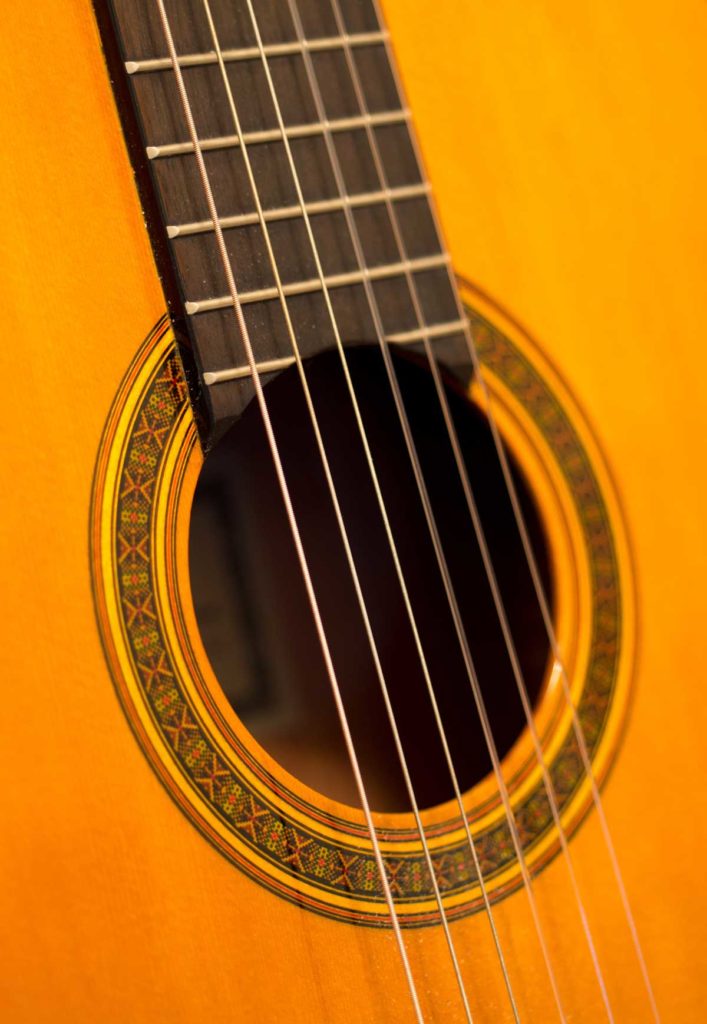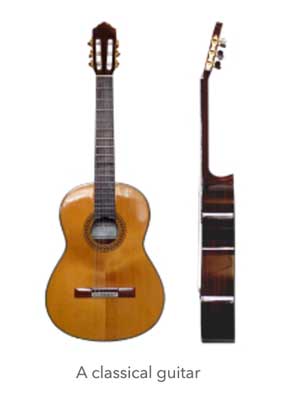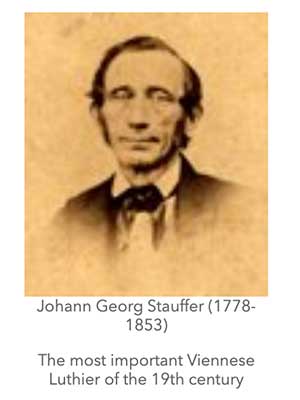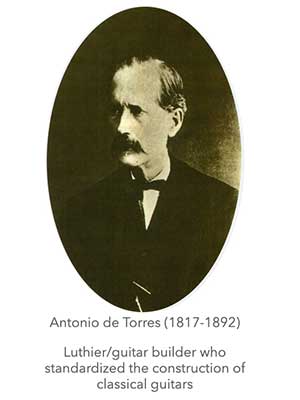Instrument Profile
Classical Guitar
As common the guitar is, there is a very special kind of guitar that, although it has been around for centuries, is not as well known — the classical guitar.
As common the guitar is, there is a very special kind of guitar that, although it has been around for centuries, is not as well known — the classical guitar.

The guitar is an instrument found in virtually every music culture around the world. Here in America, it has been an indispensable instrument in the formation of our most authentic music, from Jazz and Blues in North America, to Samba and Bossa Nova in South America, to Reggae and Bachata in the Caribbean. The guitar has always been the instrument of the people–the instrument that inspires revolutions and serenades lovers. As common the guitar is, there is a very special kind of guitar that, although it has been around for centuries, is not as well known–the classical guitar.
Often a confusing term, classical guitar (similar to classical music) does not exclusively mean music from the classical period (the period of time roughly from 1730-1820) played on the guitar. For example: the great Bossa Nova songwriters used Classical guitars, and the virtuoso Flamenco musicians from Spain use classical guitars.
It is commonly agreed among guitar players from all styles that the technique acquired by studying classical guitar (especially during the formative years) will serve as an irreplaceable foundation for playing guitar in any genre. In addition to the technique, the quality of the music composed for the classical guitar will have a positive impact on a student’s development in the realms of musical taste, ear training, and general musicianship.
Although there is evidence that many ancient cultures had some type of plucked string instrument, most researchers agree that the history of what would eventually become the modern guitar begins in the ancient Near East. The ancient Assyrians, Greeks, Romans, and Egyptians all played guitar-like instruments with familiar sounding names like Chetarah and Kithara. Very little is known about the history and development of these instruments. It is believed that they were used by people to accompany themselves as they sang or recited poetry.
During the Middle Ages, Spain was conquered by the Moors, an Arabic Muslim group known for their emphasis on the arts and learning. Spain became a meeting place for an exchange of ideas between Europe and the East that ranged from philosophy to architecture to music. By the 12th and 13th centuries, two types of guitars had emerged in Spain: the guitara morisca and the guitara latina. As the names suggest, the guitara morisca was introduced by the Moors and the guitara latina came from Europe.
By the time of the Renaissance, a variety of plucked instruments existed throughout Europe, including the lute, guitar, and vihuela. The lute had a universal appeal and became the most important and widely-used instrument of its time. The first printed instrumental music was, in fact, written for the lute. The guitar and its larger cousin, the vihuela, were popular in Spain, Italy and France. At this time the guitar had only four courses or double strings and was not used for serious music-making. That duty fell to the vihuela, a large, six-course guitar favored by the nobility in Spain. Although the vihuela was a short-lived instrument, some wonderful music was composed for it, including pavanas and fantasias collected in a book called El Maestro by Luis Milan (1500-1561), and the very first examples of variations by Luis de Narvaez (1500-1555) and Alonso Muddara. Although Milan and Narvaez did not consider the guitar an important instrument, Alonso Muddara and several other Spaniards, including Miguel de Fuenllana, did include music for the guitar among their vihuela books. In France, however, the four-course guitar became a sensation, and several books were published exclusively for the instrument by Guillaume Morlay and Adrien Le Roy (1520-1598). The Italian virtuoso Alberto da Rippa (c. 1551) also wrote several fantasies for the four-course guitar.
By the end of the 16th century, the guitar had undergone several significant changes. A fifth course was added and it became larger and more ornamental. It was no longer overshadowed by the lute and had assumed a popularity and character of its own. At first the new instrument was used for a complex system of strumming called rasgueado. Later in the 17th century, however, several composers adopted an approach that combined the playing of strums, melodies, and counterpoint to produce music of lasting value. Among the most important contributors to this new style in France were Francesco Corbetta (c. 1615-1681), by birth an Italian, and Robert de Visee (c. 1650-1725). In Spain, Gaspar Sanz (1640-1710) and Santiago de Murcia (died in 1732) wrote beautiful pieces for the instrument with interesting titles like Canarios and Passacaglia de la Cavalleria de Napoles.
By the time of J.S. Bach’s death in 1750, a new, less contrapuntal, and melodically simpler musical style was emerging in Europe. The guitar also underwent an important physical change with the elimination of the double courses and the addition of a sixth string. Its shape became more tapered at the sides and modern tuning pegs came into use. In many ways it looked similar to our modern guitar, but with one significant difference: it was still small. Throughout the 19th century, the instrument developed slowly through the efforts of master builders like Panormo, Lacote, and Stauffer, who were in constant contact with some of the era’s most admired guitar virtuosos.
The turn of the 19th century saw an unprecedented popularity of the guitar, and became known as the golden age of the instrument. This enthusiasm for the guitar came from the dedication and support of a large number of amateurs and a handful of virtuoso guitarists. The two main centers of guitar activity were Paris and Vienna. In Paris (and later also in London), the most important guitarist was Fernando Sor (1778-1839). Originally from Spain, Sor was a political refugee whose energies as both composer and guitarist became a vital source of inspiration for generations of guitarists to come. Sor composed fantasias, variations, and small character pieces, while at the same time laying down the foundation of logical and rational guitar education through his études, studies, and a famous guitar method. Among his colleagues in Paris was an Italian cellist and guitarist named Ferdinando Carulli (1770-1841) who, like Sor, contributed significant teaching materials that are still in use today. Other guitarists who made their home in Paris included Matteo Carcassi (1792-1853) and Napoleon Coste (1806-1883).
In Central and Eastern Europe, the capital of guitar playing was Vienna. Perhaps the most famous guitar citizen of the city was Mauro Giuliani (1781-1828), who came to Vienna from Italy in 1806 and for the next fifteen years wrote and played music of unprecedented originality and virtuosity. He befriended Beethoven and counted himself among the city’s musical elite. Giuliani wrote concertos, excellent chamber music, and solo music including variations, sonatas and fantasias. Although Giuliani was the star of the show other Vienna-based guitarists wrote music of exceptional value, including the Czech composer Wencesclas Matiegka (1773-1830) and later Johann Kaspar Mertz (1806-1856).
By the middle of the 19th century, the popularity of the guitar had declined significantly. The piano began to emerge as the most important instrument both in the concert hall and in homes throughout Europe. The guitar yet again fell into the role of song accompaniment. In America, some of Stephen Foster’s most beautiful songs were published with guitar parts.
In Spain, however, the guitar retained its place as a national instrument and one key guitarist, Francisco Tarrega (1852-1909), and a distinguished builder, Antonio de Torres (1817-1892), revolutionized the way guitars were made and played. Tarrega, like Sor, was from Barcelona and attracted many talented students to his hometown. He made several contributions to what we consider today to be the standard
way of sitting with the instrument, including the permanent use of the footstool. Tarrega codified the use of the free stroke and rest stroke and became famous for the technique of tremolo. He also contributed several beautiful pieces to the guitar repertoire, including Recuerdos del Alhambra and Capriccio Arabe. Tarrega was one of the first guitarists to use a new type of guitar introduced by Antonio de Torres. Torres added a system of struts inside the guitar known as fan bracing to give the instrument a louder sound and create more sustain.
Through his students, Tarrega passed on his remarkable achievements to Andrés Segovia (1893-1987), who became the most famous guitarist of the 20th century. Segovia’s contributions to guitar history are incalculable but most significantly included the commissioning of new pieces by well-known composers, elevating the guitar back to the concert hall through his extraordinary musical and personal abilities and provoking interest in the guitar through an international group of students and admirers. Thanks to Segovia, the modern guitar repertoire includes pieces by Heitor Villa-Lobos (1887-1959), Joaquin Rodrigo (1901-1999), and Joaquin Turina (1882-1949), among many others, and he realized his dream of the guitar being studied at prestigious music schools and universities alongside the piano and violin.
Although Segovia towered over his contemporaries in terms of stature and popularity, he was not alone. In Latin America, Augustin Barrios (1885-1944) made significant contributions to guitar literature with outstanding waltzes and other small character pieces. In Europe, Tarrega’s pupil and Segovia’s friend Miguel Llobet (1878-1938) was an admired soloist. Llobet also played in a duo with the Argentinian guitarist Maria Luisa Anido (1907-1997), herself an accomplished soloist.
Segovia believed in fostering talented personalities to expand the number of concertizing guitarists around the world. To a lesser or greater effect, he became an active promoter of musicians who themselves have contributed to the reestablishment of the position of the guitar. In the 1950s, 60s, and 70s, several key guitarists emerged onto the concert stage, including Alirio Diaz from Venezuela, Narcisso Yepes from Spain, Julian Bream from England, John Williams from Australia, Leo Brouwer from Cuba, and Christopher Parkening from the United States. These guitarists were supplemented by a new generation of musicians in the 1980s, including David Starobin, Goran Sollscher, the Romeros, David Russell, Manuel Barrueco, and Eduardo Fernandez, among many others.
Many of these guitarists have expanded on Segovia’s interests to enlarge the guitar repertoire by working with composers. Julian Bream in particular is the dedicatee of works by Benjamin Britten and William Walton. David Starobin has commissioned pieces from Elliott Carter, and Leo Brouwer, himself a recognized composer, has contributed significantly to the guitar repertoire with interesting and imaginative compositions.



Each of our faculty brings a wealth of performing and teaching experience to Bloomingdale. Browse their individual profiles below to learn about their unique interests, qualifications, and teaching styles.
Our private lessons are ideal for students who want a more attentive and dynamic learning experience and appreciate a one-on-one approach to learning even on a digital platform. We offer 30-minute trial lessons for only $30. Give it a try!
Please contact Registrar at registrar@bsmny.org to register or learn more at our Private Lessons page. (Please note summer rates are different than Fall/Spring.)
323 West 108th Street
New York, NY 10025
212.663.6021
Bloomingdale School of Music is a 501C3 non-profit organization EIN: 13-2562192.
© ALL RIGHTS RESERVED BLOOMINGDALE SCHOOL OF MUSIC | Privacy Policy | Website By Creative MMS
Join us for Instrument Discovery Day – January 26th, 11 AM – 1 PM. Explore the violin, guitar, trumpet, and more with the guidance of Bloomingdale’s expert faculty. Explore the violin, guitar, trumpet, and more with Bloomingdale’s expert faculty.
Free & fun for all ages!